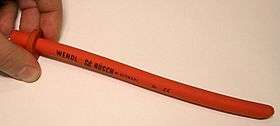Nasopharyngeal airway
In medicine, a nasopharyngeal airway, also known as an NPA, nasal trumpet (because of its flared end), or nose hose, is a type of airway adjunct, a tube that is designed to be inserted into the nasal passageway to secure an open airway. When a patient becomes unconscious, the muscles in the jaw commonly relax and can allow the tongue to slide back and obstruct the airway.[1] This makes airway management necessary, and an NPA is one of the available tools. The purpose of the flared end is to prevent the device from becoming lost inside the patient's nose.
| Nasopharyngeal airway | |
|---|---|
 Nasopharyngeal airway. | |
| ICD-9-CM | 96.01 |
Sizes
As with other catheters, NPAs are measured using the French catheter scale, but sizes are usually also quoted in millimeters.[2][3] Typical sizes include: 6.5 mm/28FR, 7.0 mm/30FR, 7.5 mm/32FR, 8.0 mm/34FR, and 8.5 mm/36FR.[4]
Indications and contraindications
These devices are used by emergency care professionals such as EMTs and paramedics in situations where an artificial form of airway maintenance is necessary, but tracheal intubation is impossible, inadvisable, or outside the practitioner's scope of practice. An NPA is often used in conscious patients where an oropharyngeal airway would trigger the gag reflex.[5][6] They are contraindicated in patients with severe facial trauma, as they may have an altered facial anatomy (particularly concerning the nasal passageways) and inserting an NPA may cause additional harm to the patient.
Insertion
The correct size airway is chosen by measuring the device on the patient: the device should reach from the patient's nostril to the earlobe or the angle of the jaw.[7] The outside of the tube is lubricated with a water-based lubricant so that it enters the nose more easily.[4] The device is inserted until the flared end rests against the nostril.[4]
References
- James R. Sills (16 March 2015). The Comprehensive Respiratory Therapist Exam Review – E-Book: Entry and Advanced Levels. Elsevier Health Sciences. pp. 336–. ISBN 978-0-323-24188-5.
- American Academy of Orthopaedic Surgeons (AAOS); Nancy L. Caroline (15 August 2017). Nancy Caroline’s Emergency Care in the Streets. Jones & Bartlett Learning. pp. 801–. ISBN 978-1-284-10488-2.
- Mick J. Sanders; Lawrence M. Lewis; Kim D. McKenna; Gary Quick (2012). Mosby's Paramedic Textbook. Jones & Bartlett Publishers. pp. 436–. ISBN 978-0-323-07275-5.
- Michael Smith; Mike Smith; American Academy of Orthopaedic Surgeons (April 2006). ACLS for EMT-Basics. Jones & Bartlett Learning. pp. 17–. ISBN 978-0-7637-4395-6.
- CHURCHIL LIVINGSTONE ELSEVIER (23 April 2012). Textbook of Paediatric Emergency Medicine, 2nd Ed. Bukupedia. pp. 476–. ISBN 978-0-7020-3368-1.
- Rachel K. Thomas; Elize Richards; Cathy Taylor (27 April 2015). Practical Medical Procedures at a Glance. John Wiley & Sons. pp. 59–. ISBN 978-1-118-63285-7.
- Daniel Limmer and Michael F. O'Keefe. 2005. Emergency Care 10th ed. Edward T. Dickinson, Ed. Pearson, Prentice Hall. Upper Saddle River, New Jersey. Page 147.